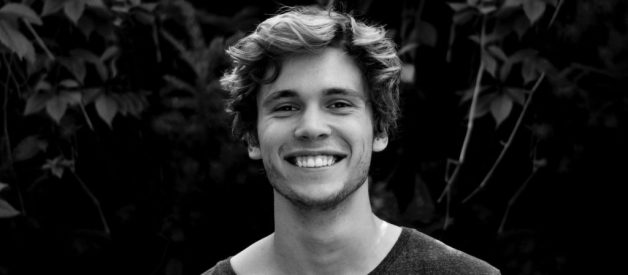PHOTOGRAPHY
Mastering a simple aesthetic that can speak volumes

Last Updated: August 9th, 2019
Black and white portrait photography is one of our favorite styles. In our long photography career, we have applied B&W stylings to all types of portraits ? individuals, couples, weddings, and so on.
While black and white photography was once the norm because there was no other option, in the modern and digital age we?re in now ? it?s an option amidst a sea of hundreds of others. Its simplicity is what has made it stand the test of time.
Black and white portrait photography is powerful!
In fact ? it is often our preferred look.
It?s such a simple aesthetic, yet can speak volumes. A skilled photographer will be able to find the balance between light and darkness in an image. Not to mention, play powerfully with light for a really dramatic effect.
Of course, few (if any) clients would actually just want a full photo gallery of black and white images, but the ones we do include have a way of captivating that color simply can?t emulate.
In this post, we?re going to give you a guided tour of how you can capture effective black and white portrait photographs. We?ll show you what to look for in a scene, how to dial in the right settings, and show you effective black and white editing tools to help tie everything together.
Digital or Film ? What?s Better for Black and White Photography?
In the early age of photography, film was the only option. Since digital cameras came onto the market, they took the world by storm. Today, you can go to any tourist hotspot and find a load of digital camera options ranging from cell phones to advanced DSLR and mirrorless camera technologies.
There are plenty of heated debates raging even as we speak as to whether or not film or digital is better. Most likely, there will never be a definitive answer to this question.
For sure ? we can appreciate both, but also accept that at the end of the day ? whether you use a film camera or a digital one ? they are just tools that allow you to capture photographs.
To simplify things for a second, the differences between film and digital are both minor and significant:
Film black and white photography ?
Many photographers find the quality of film to enhance the look of an image.
Considering this from the world of cinema, we could agree there is, at the minimum, a charm to the look of watching a movie shot on film (like the original Star Wars) when compared with modern digital movies (like the more recent Star Wars films).
The tradeoff here is that photographers have to be much more intentional in what they are shooting (a good or bad thing depending who you ask). Shooting on black and white film means purchasing a roll of black and white film and shooting through the roll until completion. There is no simple setting to switch between color & monochrome, and you?re definitely not bringing back the original color in the darkroom.
Digital black and white photography ?
Most photographers these days have gone the digital route. It?s easier and more accessible to virtually anyone. On one hand, you could argue that this kills some of the mystique of photography, but we generally see it as a great thing because people take photos for so many reasons ranging from documenting personal experiences to creating fine art. Without a doubt, taking a digital image is 1,000 times easier than film ? and this is heavily because of how we can tweak an image after it?s been taken.
It must be said to keep within the theme of this post ? taking digital photos will be the more modern approach to photography.
Ultimately ? whether you choose to shoot on film or digital, most of the advice provided through the rest of this post will apply to you. We will be adding little notes here and there talking about some differences or adjustments you may need to make depending on this factor as well.
Should I Shoot in Black and White OR Shoot in Color and Convert Later?
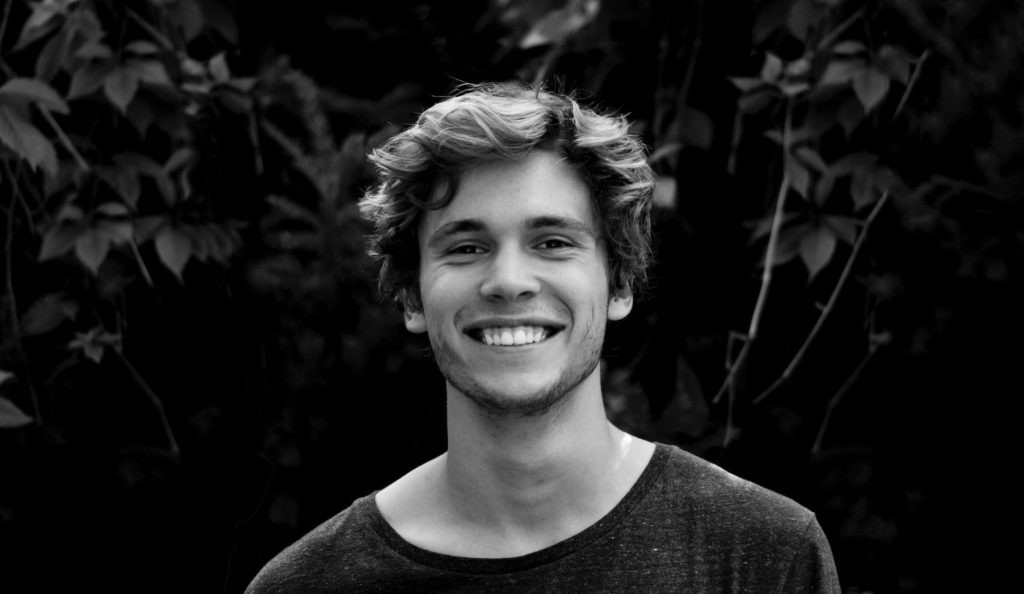
This is a very common question we hear again and again when talking about black and white photography in general. It stems from digital cameras allowing photographers to shoot in a monochrome or color setting.
On the surface, it may seem like you need to make a hard choice, but reality is far different!
Unless you are shooting on film where the choice is forced upon you, when taking digital images in the RAW file format ? you can shoot in either B&W or color and convert between the two later in post-production.
If you have no interest in photo editing of any sort, then shooting directly to black and white would make sense for you.If your photography approach will include some level of post-production (and we recommend you stay open to this!), RAW files are the way to go so you can retain all color data in your image file.
In practice, the benefit of shooting directly to black and white is that you can see the actual result on your camera?s LCD screen. As you become more skilled as a photographer and begin to visualize the world around you better, it?s entirely possible to shoot in color and be able to picture what it will look like accurately in black and white.
TLDR: Take pictures in camera RAW file format, shoot in color/monochrome ? whichever you prefer and are comfortable with, and make adjustments later when you edit your images. This is the modern black and white photography approach!!
Black and White Portrait Photography ? What?s the Purpose?
The mistake many photographers make with black and white images is simply throwing a moody preset on an image and calling it a day. While this is a simple (and common?) solution, it doesn?t lead to effective images.
When thinking about taking black and white portraits, you need to ask yourself: how will this photo benefit from being in black and white instead of color?
This answer will vary from photographer to photographer, and even shoot to shoot.
Some of the lures of black and white image edits for us is that they can convey extra emotion.
For example, when we take couple?s wedding portraits, there is already an energy in the air. Couple?s are buzzed with love, passion, romance, and all these other intangible things that happen to come out beautifully in a portrait image.
You could easily see the same in solo portraits. Some of our absolute favorite portrait shots that we have seen are just a person on their own in the midst of experiencing some strong emotion. The most powerful of these end up on newspaper covers taken in war-torn locales and similar.
While you don?t have to go crazy and down the philosophical rabbit-hole, it?s important to think about what is motivating the want to have an image in black and white. It can be as simple or complex as you want it to be, but this motivation will help give your image a point for existing ? and help you make other determinations when it comes to your camera settings, choice of location, and so on.
A Good Photograph is Good in Color or Black & White
For the most part, images taken in color will translate well to black and white if the photographs are taken well.
This means that all of the fundamentals of photography that you should be applying no matter what including rules on composition, lighting, and making adjustments on your camera ? will all be in play.
The best black and white portrait photographs require successful application of these things but will be enhanced most by the subject matter.
5 Special Tips for Black and White Portrait Photography
Now that we?ve covered some of the essentials of black and white photography, we?re going to narrow things down to just talking about black and white portrait photography.
1. Color Plays a Powerful Role in Black and White Photography
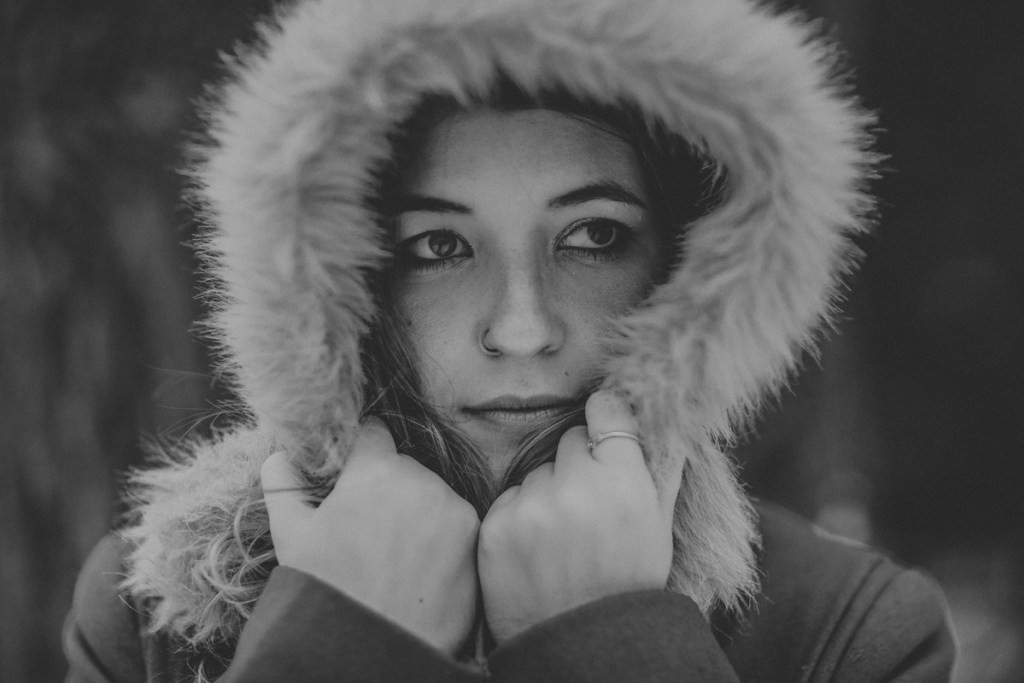
Despite what you may be thinking, black and white images are actually entirely impacted by the colors on display in the subject and surrounding environment.
This is something we?ve come to learn heavily as we tweak images in Lightroom ? making changes to the color sliders and watching how the photo is impacted.
Because of this, one of the things we strongly recommend is to have color separation in your images.
Here is one way to achieve this:
Say you are going to photograph a person outside in a wide-open grassy field. Think for a minute about the colors that will dominate the frame already: blue skies, green grass. This means the sky portion of the shot will be pretty consistent, and the grass portion of the shot will be consistent. Now, when you add your portrait subject into the mix ? they are going to bring a lot of color into the scene that can enhance things or make them muddy. A great solution is to recommend that the model wears something that separates them from the background ? so steering away from shades of blue or green in their attire.
Yes, this may mean in some cases that the model may end up wearing color clothing that they don?t care for ? but it?s good to remind them that it won?t matter in the end for black and white images.
Example from Lightroom:
This is a recent couple?s portrait (Link opens to the original article, entitled The Ultimate Guide to Couples Portrait Photography, on our website FormedFromLight.com, OR read it right here on Medium!) we took. To help illustrate how color impacts the black and white image result ? we kept the settings the same in both of the images below, but only moved the GREEN color slider. Can you spot the difference??
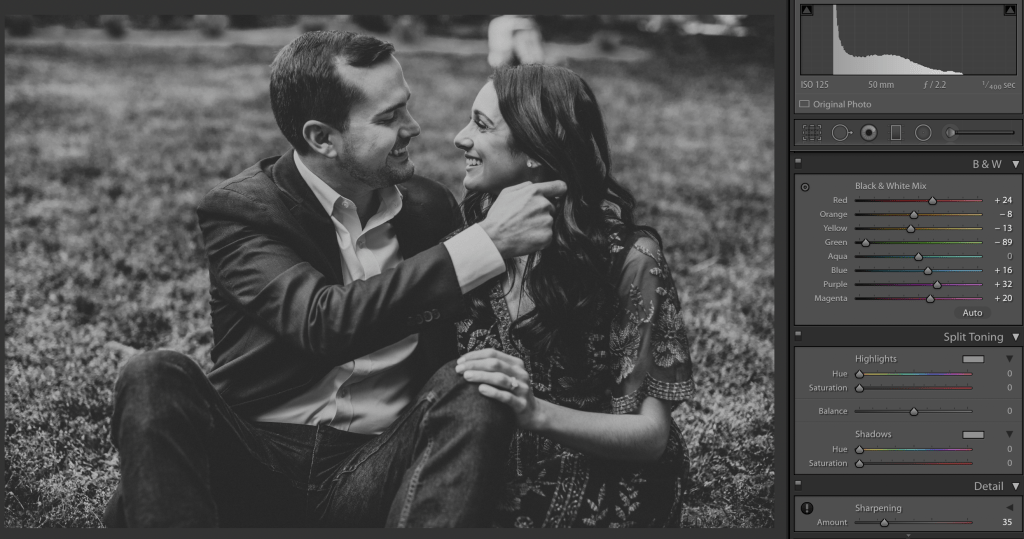
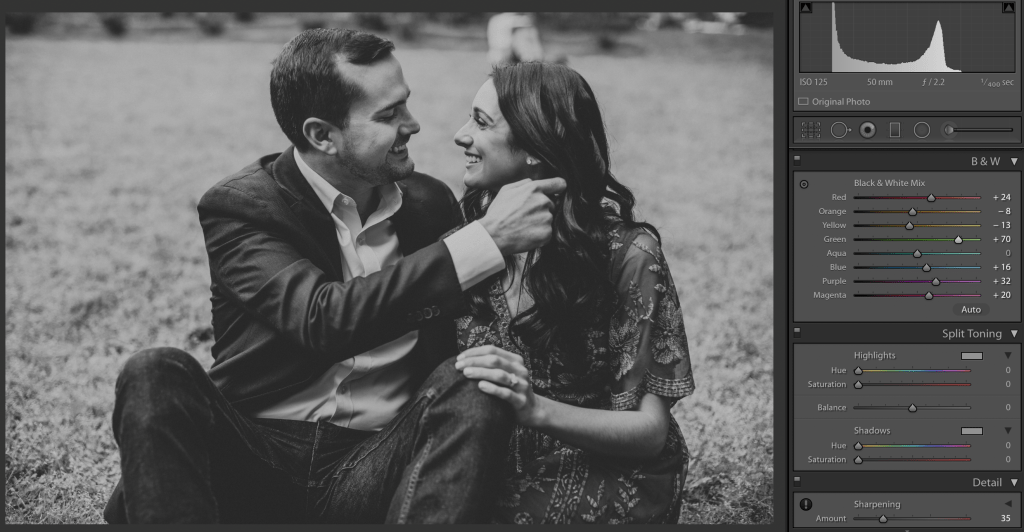
2. Contrast Matters Even More
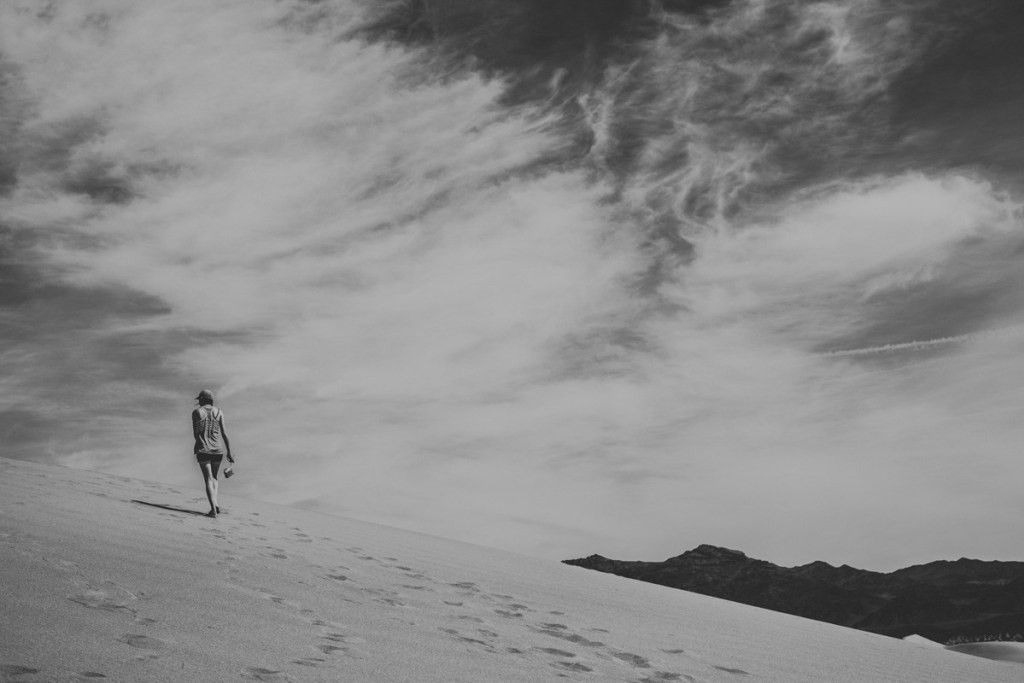
In black and white portrait photography, you could view contrast as the difference between ?real black? and ?real white?.
There are a million shades of grey in between that becomes populated depending on the colors in the environment, available light, and other factors.
By selecting compositions that enable more contrast, and making adjustments in your black and white photo editing workflow to increase the amount of contrast ? you will find yourself with a more powerful end result.
3. Simple Backgrounds Make Powerful Portraits

Black and white portrait photography benefits from simplicity. When the image is all about the subject, the background can turn into a complementary negative space that allows the person(s) in the photo to have breathing room. So often, our choice of background will be a flat colored wall for this very reason.
Pro tip: If you don?t have a simple background readily at your disposal, the good news is that you can effectively create one in camera. By using a wide aperture (Link opens to the original article, entitled What is the Best Aperture for Portraits?, on our website FormedFromLight.com, OR read it right here on Medium!), you can separate the subject from the background ? blurring out the background into a mixture of color and fractals. In a pinch, this is something we love to do ? in some environments it adds a very organic and watercolor looking texture that you can?t go wrong with. It also makes spots that might be tricky to photograph with a lot going on much easier.
4. Use Environmental Effects to Add Natural Depth to an Image
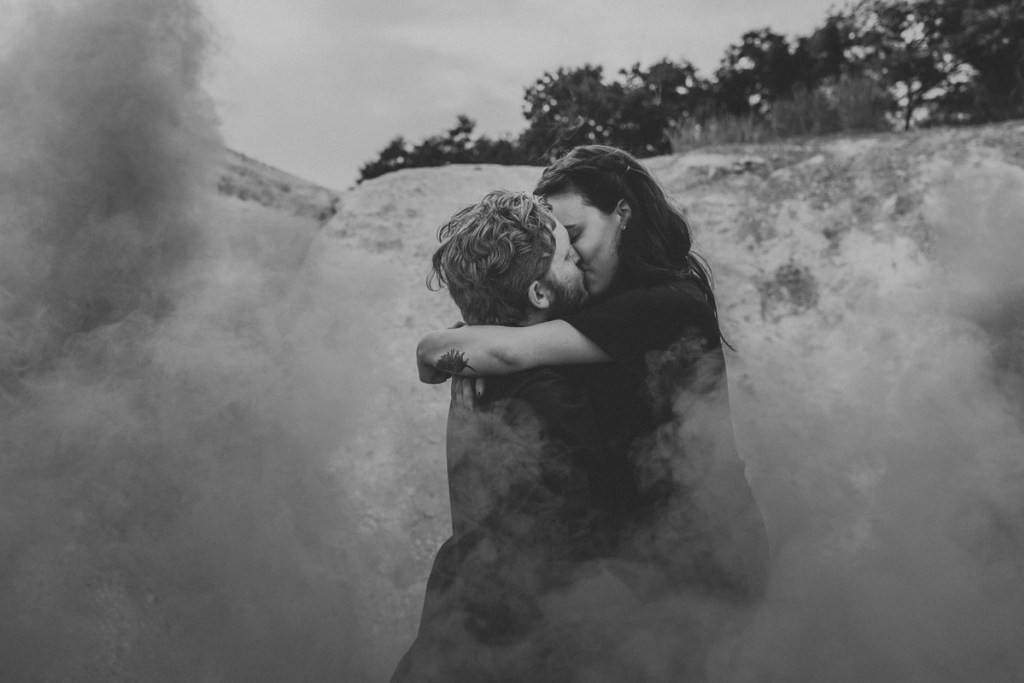
Black and white portrait photography is really synonymous with moody photography ? so utilizing things in nature to build the tension and increase the moodiness is always welcome.
When shooting portraits we plan to convert into B&W images, we will often try to work during the parts of the day that provide more interesting lighting and textures. A few things that come to mind that complement a black and white portrait:
- Golden hour light
- Fog and mist
- Rain and snow
- Mud and dirt
For the most part ? you will need to plan your shoot around the weather. This tends to be the case for any type of outdoor portrait photography.
Of course ? there are also products available that help to replicate some of these natural effects. A few we love to use include:
- Atmospheric Aerosol. This is basically fog in a can. Spray it like hair spray into the environment ? works well both outside and indoors (especially next to window light!!). You can pick up a can on the cheap via Amazon.
- Smoke bombs. As the name implies, this generates smoke which is a really great effect for portraits. We wrote a whole post on smoke bomb photography, too!
5. Extract Strong Emotional Responses from Your Portrait Subject
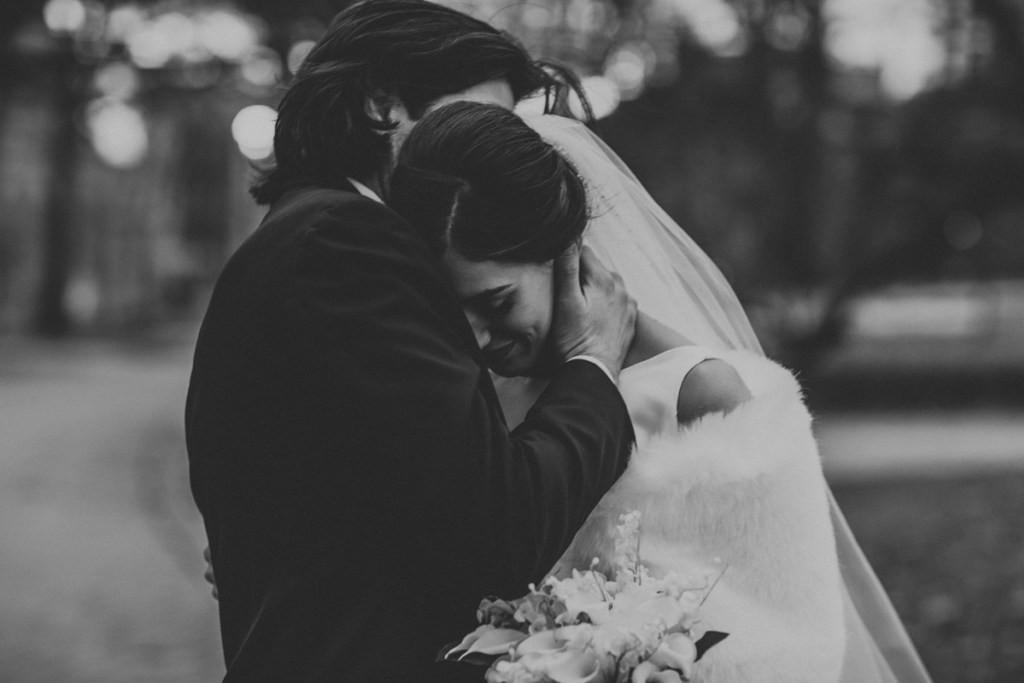
For us, the best black and white portrait photographs we?ve ever taken have a lot of emotion on display.
This can be very literal ? get your portrait subject to actively evoke a strong emotion. What triggers each person will vary (and you should be mindful ? especially if you?re trying to elicit emotions like anger, depression, sadness, etc. ? as these types of shots often require a good deal of trust between photographer and the portrait subject).
However ? the best way we?ve come to get our portrait subjects to showcase authentic emotion in front of the camera is by setting up scenarios so they stop thinking about being photographed.
For example, let?s say you want to capture a portrait of a person crying tears of joy. The photo would turn out really great, but getting this sort of response is very challenging. At the most extreme, you could try to set things up so something happens that would cause that type of reaction naturally. For example, you could work with the portrait subject?s significant other to do something really extravagant as a surprise that might naturally end up in that type of result. But, something like that just isn?t normally all that feasible.
On the other end, you could approach it as a mental game. By using prompts, you can get your portrait subject to think about a situation and their response to it. For some people, it could be easy ? ?Think about a time where you felt so much joy that you cried!?, then start talking about it together.
Through it all, building a relationship with your portrait subject through communication is the best way to get to these strong emotional portraits that do so well in black and white.
This article was originally published on Formed From Light (FormedFromLight.com) on July 4, 2019 and was written by Jes and Chris Romans.
Enjoyed this story?
If so, click on the following links to visit and read some of our other most viewed and read Medium stories that have been selected by Medium?s curators for curation and distribution into the Photography topic on Medium:
- How Do You Take Amazing Pictures?
- Photography Basics ? The Exposure Triangle
- What is the Best Aperture for Portraits?
- 7 Tips for Taking Pictures to Turn into Wall Art for Your Home
- 10 Photography Ideas at Home for Beginners
- Is Photography an Expensive Hobby?
- How to Get Your First Client as a Photographer
- What is the Best Camera Setting for Outdoor Portraits? (WITH EXAMPLES!)
- How to Take Better Portraits in Low Light
- The Several Thousand Dollar Question ? Should I Upgrade to a Pro Camera Body?
- The Extremes We Go to For a Shot ? A Landscape Photographer?s Tale
- The Most Photogenic Spot on the Oregon Coast!
- The 5 Greatest Mistakes Small Business Owners Make ? As Told By An Attorney
- How to Photograph Icelandic Glaciers
- How Determined Do You Have to Be to Make Photography Your Career?
- Is Photography a Good Career? Yes!!
- The Best Photography Gear for an Iceland Adventure
- How to Put Together an Easy Styled Shoot
- How Much Should a First Time Wedding Photographer Cost?
- The Ultimate Guide to Couples Portrait Photography
- A Short Guide to 4 Lighting Scenarios for Photographers

- Subscribe to Storius Direct to receive articles like this to your inbox
- Subscribe to Storius Digest to receive a weekly digest with links
Elsewhere: LinkedIn ? Facebook ? Instagram ? Twitter ? Flipboard
